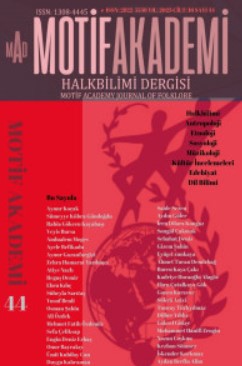ŞAH İSMAİL İLE GÜLİZAR HİKÂYESİ İÇİN YENİ BİR KAYNAK: BOYABAT VARYANTI
A NEW SOURCE FOR THE NARRATIVE OF SHAH ISHMAIL AND GULIZAR: BOYABAT VARIANT
Author(s): Atiye NazlıSubject(s): Cultural history, Customs / Folklore, Oral history
Published by: Motif Halk Oyunları Eğitim ve Öğretim Vakfı
Keywords: Folk narrative; Shah Ismail; poetry; oral tradition; transformation;
Summary/Abstract: Folk narratives are a type of folk literature in verse and prose told by minstrels and public storytellers in Anatolia since the 16th century. In terms of its subjects, it is classified as love, heroism or love and heroism. Until television and cinema, that is, the silver screen, came into our lives towards the end of the 20th century, they undertook the socialisation of the people as well as the task of education and cultural transmission. The heroes of the folk narrative on which hundreds of studies have been carried out can be minstrels, mythical and imaginary heroes, or sultans, poets, or beys who lived in history and were important for that society. The hero of the narrative we discussed in our study is Shah Ismail. Although he did not live in Turkey, the folk narrative about his life is found in almost every province from east to west. Although Shah Ismail, who is considered a folk hero, is generally regarded as a lover struggling to meet his beloved in narratives, he is sometimes included as a hero in the story co-texts. The fictional structure of Shah Ismail's narratives is parallel in written and oral sources but can sometimes be long or short depending on the narrator. In general, the verse parts of folk narratives in written sources are not included in oral sources very much. Although there are verses and quatrains with missing verse parts in the "Shah Ismail and Gülizar Narrative", which is the subject of our analysis, it must be sung in a melodious form in the sound recording. Even though the source person is not a folk narrators or minstrel, singing the verse parts of the story melodiously is important in terms of the continuation of the folk narrators tradition in the late 20th century. The compilation discussed in our article was compiled in 1984 by the source person living in the old Nefsidere village of Sinop-Boyabat district, now called Dereçatı village. In our study, the verse parts of the folk narrative will be given in full.
Journal: Motif Akademi Halkbilimi Dergisi
- Issue Year: 16/2023
- Issue No: 44
- Page Range: 1628-1648
- Page Count: 21
- Language: Turkish

